Laundry Symbol Guide: Do you know the meaning of Japanese iron care symbols?

Laundry Symbols can be confusing, especially when it comes to cross-border symbols. Do you know that Japanese Laundry Symbols are different from other countries? Let’s find out together!
Since ironing is required for wrinkled clothes, people think ironing is a hassle.
If you know the characteristics of fabrics and iron them efficiently, you can reduce the time required for ironing.
Ironing Mechanism
Fibers
The fibers that make up fabrics are composed of many molecules, each of which is connected by intermolecular forces.
In a wrinkle-free garment, molecules are arranged in a regular pattern and connected by intermolecular forces.
Principle of wrinkle formation
Intermolecular force is a weak force, so if more force is applied from the outside, the molecules are united and their alignment is disrupted, causing wrinkles to form.
Washing causes the fiber to swell with moisture. The intermolecular forces are loosened by this, and the strong forces during washing cause the molecules to become disordered.
If the fabric is dried while the molecules are still in disarray, the intermolecular forces will keep the molecules in the same order, resulting in wrinkling.
How wrinkles are ironed out
When ironing out wrinkles, the key elements are moisture, heat, and pressure.
First, steam is applied to the iron to moisten the fiber.
As mentioned in the previous section on the principle of wrinkle formation, moist fibers swell and become soft.
This loosens the intermolecular forces that cause wrinkles, making it easier to stretch out the wrinkles.
Next, the heat from the iron activates the movement of the molecules.
Since the molecules are in a state of easy movement, it is easier to correct the disordered molecular alignment and wrinkles are more easily stretched.
The pressure caused by the iron’s own weight then corrects the molecular alignment.
The molecules are rearranged evenly by applying pressure, and the wrinkles are elongated.
Finally, when the heat is cooled down, the movement of the molecules is controlled, and the molecules are connected to each other by intermolecular forces, so that they stay in their original wrinkle-free state.
This is how ironing works. For fabrics made of moisture-sensitive materials, the heat and weight of the iron must be used to stretch out the wrinkles without applying steam, but steam is ideal for stretching out stubborn wrinkles.
Cautions when ironing
There are a few things to keep in mind when trying to iron out wrinkles.
Flakiness
When the iron is pressed too hard, causing marks to appear in areas where there is a difference in thickness. Flakiness is often caused by a seam allowance.
There are ways to avoid flakiness , such as not pressing the iron too hard, ironing from the reverse side, and placing a piece of cardboard under the seam allowance.
Shine
Shine is when the weight of the ironing iron breaks the roundness of the fiber, creating a surface on the fiber that reflects light and makes it shiny.
This can also be prevented by not pressing down on the iron when ironing and by applying a cloth to the iron.
Ironing symbols
Some materials are more sensitive to heat than others, so it is necessary to iron at a temperature appropriate for the material according to the laundry label.
High temperature

Iron at 180°C to 210°C.
Materials suitable for ironing at high temperatures are Cotton and linen.
Medium temperature

Iron at 140°C to 160°C.
Materials suitable for ironing at medium temperature are Wool, silk, rayon, nylon, cupro, and polyester.
Low temperature

Iron at temperatures between 80°C and 120°C.
Materials suitable for ironing at low are crylic, acetate, and polyurethane.
Cannot be ironed.

Items that cannot be ironed include Python, furs, and willow fabrics are examples of materials that cannot be ironed.
They are not suitable for ironing because they are sensitive to heat and will shrink or change in shape.
Conclusion
The ironing temperature and method appropriate for the fabric will not only iron out wrinkles beautifully without damaging the garment, but will also be more efficient and save time.
To see more fabrics, trims and accessories, please take a look at ApparelX’s product list.



